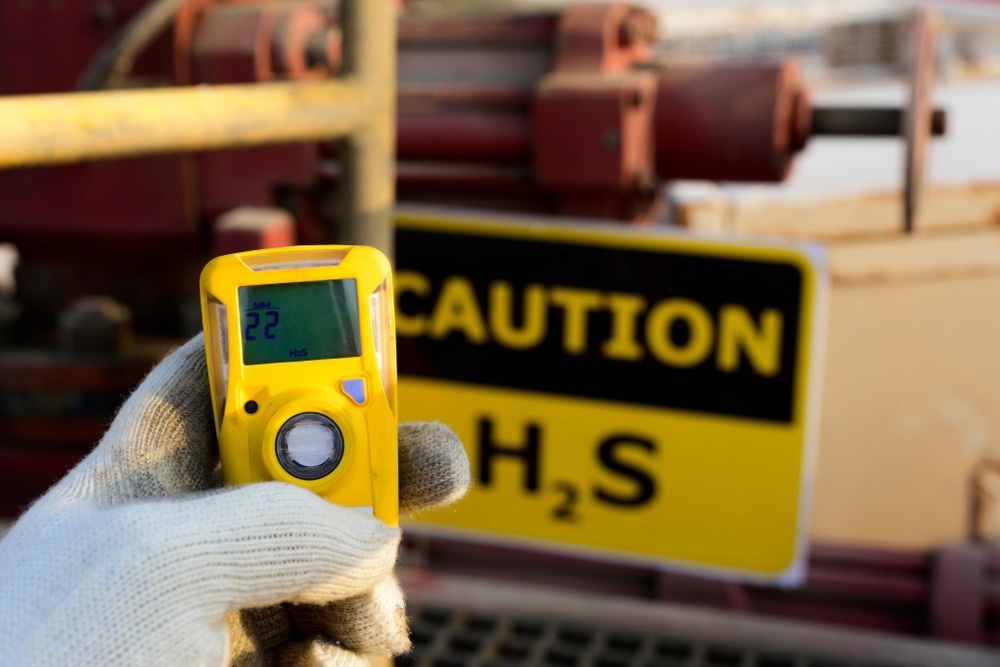A paper printed in the Journal of Alloys and Compounds reported a microscale hydrogen sulfide (H2S) gas sensor using a 2D-0D heterostructure based on MOSe2/ZnO. The MOSe2/ZnO nanocomposite was synthesized using a unique complementary metal oxide semiconductor suitable microwave-irradiation-aided solvothermal process.

Study: 2D-MoSe2/0D-ZnO nanocomposite for improved H2S gas sensing in dry air ambience. Image Credit: P.V.R.Murty/Shutterstock.com
The Importance of H2S Gas Detection
Hydrogen sulfide (H2S) is a highly poisonous, dangerous, and flammable gas. Natural sources of H2S gas include unrefined petroleum, natural gas, and the bacterial decomposition of human and animal waste.
Lower H2S gas concentrations can cause a variety of serious health issues, including eye and throat damage, impaired memory, and loss of balance. At higher concentrations, H2S gas causes sudden death.
Better precision in quantifying H2S gas is therefore crucial, and numerous attempts have been undertaken in this direction.
Advances in H2S Gas Sensing
For sensing H2S gas, a range of materials and procedures have been utilized. Some of the most common approaches are electrolytic (based on solid electrolytes), piezoelectric, optic, and surface acoustic wave methods. Some of the significant materials utilized in this endeavor include oxides of metals (MOXs), metal oxide/metal oxide (MOX/MOX) composites, and polymeric composites.
While qualities including specificity, sensitivity, and reproducibility are essential for effective sensing devices, the limit of detection (LOD) is the crucial factor that defines the sensor's applicability for a certain application.
An LOD ranging from 0.1 to 10 parts per million (ppm) accommodates trace amounts of H2S gas to the concentrations which begin to cause physical discomfort. Therefore, such an LOD range is sufficient for most applications.
H2S Gas Sensors Based on Metal Oxides
Most sensing devices are resistive, relying on polymers and oxides of metals. Unfortunately, MOX-based H2S gas sensors suffer from poor specificity, while long-term durability and dependability are the major concerns in polymeric chemiresistive sensing devices.
Several attempts have already been undertaken to increase the sensing capability of H2S gas sensors. Doping, functionalization with metallic nanoparticles, and the development of nanocomposites and nanohybrids have improved H2S gas sensing performance thanks to a synergistic impact at the intersection of two distinct nanostructures.
Nanocomposites and nanohybrids provide an advantage over raw nanomaterials regarding improvements in detection parameters.
The Role of Transition Metal Compounds in H2S Gas Sensing
2D transition metal dichalcogenides (TMDs) have recently received interest in H2S gas sensing. Researchers have used nanohybrids and nanocomposites of TMDs with TMDs and MOXs to detect H2S gas in trace amounts.
The majority of TMD/MOX-based nanoscale composites are outperformed by transition metal sulfide (TMS)-based nanocomposites, which have been thoroughly investigated hypothetically as well as experimentally.
To meet the required sensing range and specificity for H2S gas, a novel composite material as well as a unique synthesis process, must be investigated. Transition metal selenide (TMSe)-based nanocomposites may be an acceptable option in this respect.
TMSe/MOX nanohybrids and nanocomposites have already been proven in a variety of uses like batteries, photocatalytic procedures, and electrochemical monitors.
Highlights of the Study
In this study, the team developed a chemiresistive H2S gas detector using an MoSe2/ZnO nanocomposite via a top-down technique that involved the liquid exfoliation of MoSe2 films, coupled with a bottom-up technique that involved the microwave-irradiation-aided coating of zinc oxide NPs onto the MoSe2 films.
The H2S gas detection capacity of the developed nanocomposite was tested at 150 oC and then compared against that of separate MoSe2 and ZnO in comparable settings.
Important Findings
Using a two-stage wet chemistry approach to create MoSe2/ZnO nanocomposites, the team developed an H2S gas sensor which was found to be highly responsive and specific towards H2S gas at an elevated temperature of around 150 ºC.
This nanomaterial-based chemiresistive device exhibited good response and recovery times (690 s and 665 s, respectively, for 4 ppm H2S gas).
The sensing system was evaluated for important gas sensing properties, including specificity, repeatability, hysteresis error, and linearity. The effectiveness of the MoSe2/ZnO-based sensing device was compared against that of various nanocomposite-based sensors and the developed H2S gas sensor was found to be competitive.
Based on the sensing and material characterization data and literature-based intuition, the team developed a viable detection mechanism for H2S gas.
These findings suggested that the developed nanocomposite may be an extremely effective sensing material for detecting H2S gas. This work may open the door for further research into different TMD-based detection materials using the microwave-irradiation-aided hydrothermal technique.
Reference
Jha, R. K., Nanda, A., Yadav, A., Sai, R., & Bhat, N. (2022). 2D-MoSe2/0D-ZnO Nanocomposite for Improved H2S Gas Sensing in Dry Air Ambience. Journal of Alloys and Compounds. Available at: https://www.sciencedirect.com/science/article/pii/S0925838822032169?via%3Dihub
Disclaimer: The views expressed here are those of the author expressed in their private capacity and do not necessarily represent the views of AZoM.com Limited T/A AZoNetwork the owner and operator of this website. This disclaimer forms part of the Terms and conditions of use of this website.